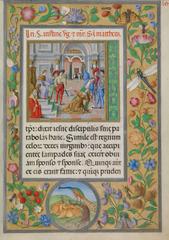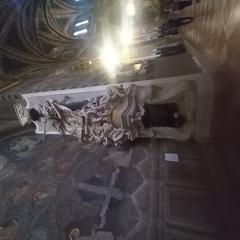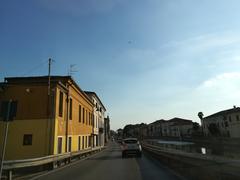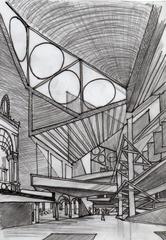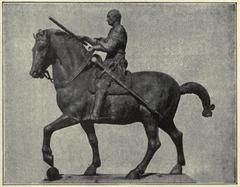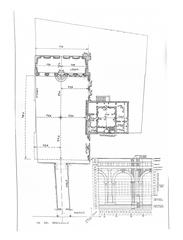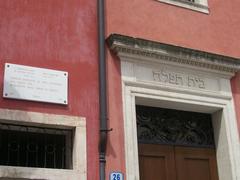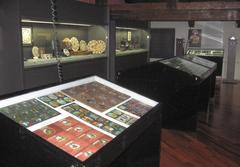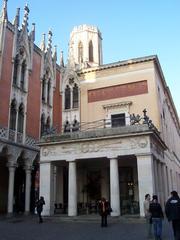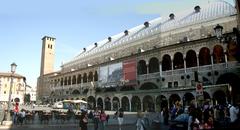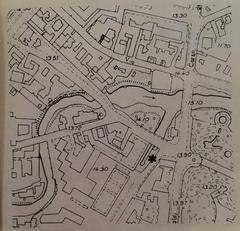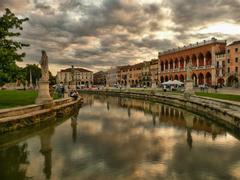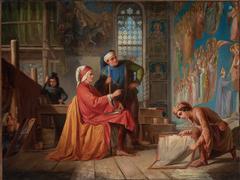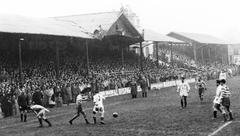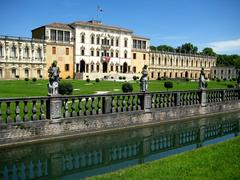Biblioteca del Seminario Padua: Complete Visiting Hours, Tickets, and Historical Sites Guide
Date: 14/06/2025
Introduction
The Biblioteca del Seminario in Padua stands as one of northern Italy’s most treasured historical and scholarly institutions. Founded in the late 16th century to support the education of clergy following the Council of Trent, the library has evolved into a guardian of rare manuscripts, incunabula, and scientific works, including the prized first edition of Galileo Galilei’s “Dialogo sopra i due massimi sistemi del mondo.” Nestled in Padua’s historic center—home to Italy’s second-oldest university and a crucible of Renaissance thought—the library offers a profound window into the city’s religious, cultural, and intellectual past (abano.it; bibliotecaseminariopda.it).
This detailed guide provides everything visitors need to know: from the library’s historical foundations and architectural highlights to practical information on visiting hours, tickets, accessibility, and expert tips for a rewarding experience. Whether you are a scholar, culture enthusiast, or traveler exploring Padua’s historical sites, this resource will help you plan your visit and enrich your understanding of this remarkable library.
Table of Contents
- Historical Foundations
- Architectural Heritage and Interior Design
- Notable Collections and Manuscripts
- Restoration and Preservation
- Visitor Experience: Hours, Tickets, and Tours
- Location and Access
- Accessibility
- Frequently Asked Questions (FAQ)
- Nearby Amenities
- Plan Your Visit: Tips and Recommendations
- References
Historical Foundations
The Biblioteca del Seminario Vescovile di Padova was established soon after the Council of Trent (1545–1563), integral to the Catholic Church’s educational reforms. Its creation paralleled the founding of Padua’s diocesan seminary, with the initial aim of supporting the formation of priests through access to essential theological and liturgical texts (abano.it).
The collection steadily grew, especially during the Napoleonic suppression of religious orders, when books and manuscripts from dissolved institutions were transferred here. The library’s evolution mirrored Padua’s reputation as a center of scholarship, complementing its renowned university and playing a vital role in the city’s intellectual and religious life (ISSR Padova).
Significant structural enhancements occurred in the late 18th and early 20th centuries, most notably under Cardinal Gregorio Barbarigo and later renovations, which resulted in the three grand eighteenth-century halls that house the Ancient Section today (bibliotecaseminariopda.it).
Architectural Heritage and Interior Design
The library is housed within the Seminario Maggiore complex in Padua’s historic center. Its architecture is a harmonious blend of Renaissance sobriety and Baroque refinement, featuring a stately stone façade and dignified interiors (italien-entdecken.de).
Highlights include:
- Sala Rossa (Red Hall) and Sala Nera (Black Hall): Designed by Giovanni Gloria (1720–1740), these halls boast vaulted ceilings and original wooden shelving, creating an atmosphere of scholarly grandeur.
- Sala del Forcellini: Renowned for its six monumental bookcases, echoing the craftsmanship of Andrea Brustolon.
Natural light floods the main reading rooms, illuminating centuries-old tomes and enhancing the contemplative ambiance. Smaller alcoves safeguard rare volumes, while displays on the Seminary’s educational legacy offer further context (hellomondo.com).
Notable Collections and Manuscripts
The Biblioteca del Seminario’s holdings encompass over 200,000 volumes, including:
- Medieval and Renaissance Manuscripts: 224 Latin manuscripts and select works in Greek, Hebrew, and Arabic, spanning theology, philosophy, and science (bibliotecaseminariopda.it).
- Incunabula: 483 rare books printed before 1501, alongside over 10,500 “cinquecentine” (16th-century books).
- Illuminated Treasures: A 15th-century copy of Petrarch’s “Canzoniere” (Cod. 45) and a beautifully decorated edition of Pliny the Elder’s “Historia Naturalis” (Venice, 1472) (bibliotecaseminariopda.it).
- Galileo’s “Dialogo”: The first edition of Galileo’s pivotal work, complete with his handwritten notes, reflecting Padua’s legacy in scientific history (theartpostblog.com; arturorobertazzi.it).
- Scientific Instruments: The Gabinetto di Fisica features hundreds of historical scientific devices, including a Voltaic pile attributed to Alessandro Volta and a telescope inspired by James Gregory (Wikipedia).
Additional highlights include rare translations (such as a late 17th-century Italian Quran), the Forcellini Lexicon (a touchstone of classical scholarship), and numismatic/archaeological collections (bibliotecaseminariopda.it).
Restoration and Preservation
The library is committed to the ongoing conservation of its rare and fragile materials. Recent restoration projects have included a German Bible translated by Martin Luther (Wittenberg, 1556), illuminated manuscripts, and important scientific treatises. These efforts are often supported by local foundations and are essential for ensuring the library’s collections remain accessible for generations to come (bibliotecaseminariopda.it).
Visitor Experience: Hours, Tickets, and Tours
Visiting Hours
- Ancient Section: Access is by guided tour or special arrangement only.
- Modern Section: Open Monday to Thursday, 9:00–17:50; Friday, 9:00–13:00.
Advance booking is essential for all visits. The library remains closed on weekends and public holidays (bibliotecaseminariopda.it).
Tickets and Admission
- General Admission: Free for individual scholars and academic visitors.
- Guided Tours: Require advance booking and a small donation (typically €3–5 per person) to support preservation projects.
Guided Tours and Special Events
Guided tours offer access to the main reading rooms, rare collections, and temporary exhibitions. Thematic tours focus on figures such as Galileo, Petrarch, and Dante, as well as the seminary’s scientific legacy. Tours are tailored for groups (up to 25) and can be customized for schools or cultural associations.
The library also participates in cultural festivals and European Heritage Days, occasionally opening its doors to the wider public for special events (abano.it).
Accessibility
Recent renovations have improved accessibility, with ramps and elevators in key areas. Some historic sections may still pose challenges; visitors with mobility concerns should contact the library in advance to arrange accommodations.
Location and Access
- Address: Via Seminario 29, 35122 Padova, Italy
- Phone: +39 049 664116
- Email: [email protected]
- Official Website: ISSR Padova - Biblioteca
The Biblioteca del Seminario is centrally located, within walking distance of Padua’s cathedral, the Basilica of St. Anthony, the Diocesan Museum, and other major sites. It is easily accessible by public transport; parking for bicycles is available, but car parking is not provided (Wikipedia; My Italian Diaries).
Frequently Asked Questions (FAQ)
Q: What are the library’s visiting hours?
A: The Ancient Section is accessible by appointment or guided tour; the Modern Section is open Mon–Thu 9:00–17:50, Fri 9:00–13:00.
Q: Are tickets required?
A: General research visits are free. Guided tours require advance booking and a small donation.
Q: How do I book a tour?
A: Contact the library by phone or email in advance. Group and school visits can be arranged with notice.
Q: Is the library accessible to visitors with disabilities?
A: Most areas are accessible, but inform the staff in advance for specific needs.
Q: Can I take photos inside?
A: Photography is generally restricted to protect collections. Exterior and seminary grounds may be photographed with permission.
Nearby Amenities
- Tourist Information: Offices are located at the train station and near Caffè Pedrocchi (Rossi Writes).
- Dining: Numerous cafés and restaurants are within walking distance.
- Accommodation: From luxury hotels to guesthouses; booking ahead is recommended (Miss Tourist).
Plan Your Visit: Tips and Recommendations
- Book Early: Visits and tours require advance notice due to limited public hours.
- Combine Attractions: The library is close to Padua’s main historical sites; plan a full cultural day.
- Dress Modestly: Respect the seminary setting and maintain silence during your visit.
- Check for Events: Watch for open days or exhibitions during cultural festivals.
- Support Preservation: Donations during tours directly contribute to ongoing conservation efforts.
References and Further Reading
- Visiting Biblioteca Del Seminario in Padua: History, Tickets, Hours, and Visitor Guide, 2025, abano.it (abano.it)
- Biblioteca del Seminario Vescovile di Padova: Visiting Hours, Tickets, History, and Cultural Highlights in Padua, 2025, bibliotecaseminariopda.it (bibliotecaseminariopda.it)
- How to Visit Biblioteca del Seminario in Padua: Visiting Hours, Tickets, and Insider Tips, 2025, ISSR Padova (ISSR Padova)
- Visiting the Biblioteca del Seminario in Padua: Hours, Tickets, and Historical Insights, 2025, Seminario Maggiore (Seminario Maggiore)
- Galileo in Padua – An Itinerary to Visit the Places of Galileo, 2024, theartpostblog.com (theartpostblog.com)
- Padua Attractions and Travel Tips, 2025, Miss Tourist (Miss Tourist)
Plan your visit today to immerse yourself in the profound legacy of the Biblioteca del Seminario. For more travel insights and cultural guides, download the Audiala app and explore our related articles.
